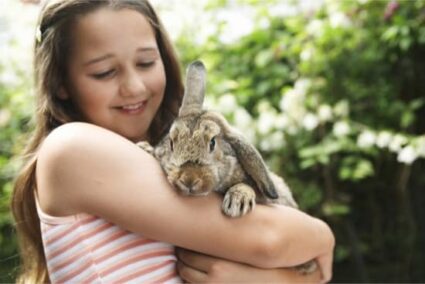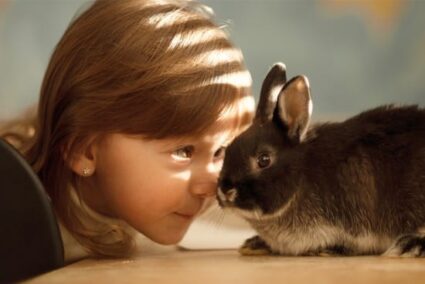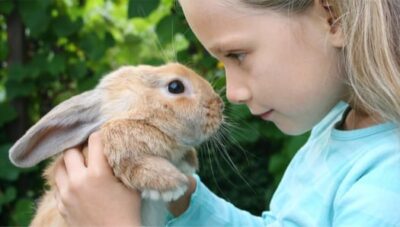Pet rabbits are sweet and adorable companions to have around the family home. However, there’s more to caring for rabbits than just giving them cuddles and feeding them hay. While they can make wonderful pets, there are also some drawbacks to rabbit ownership.
Rabbits are smart. They can be litterbox trained and taught tricks. They don’t make much noise and develop strong bonds with their owners. However, rabbits love to chew and scratch everything in sight. They need exercise, and they can be time-consuming to look after.
There are many benefits to keeping a rabbit as a pet, aside from their cuteness. We’re going to look closely at these advantages. However, we’ll also look at the disadvantages, to find out why rabbits aren’t always appropriate indoor pets for everyone.
Why Do Rabbits Make Good Pets?
Rabbits are among the best household companion animals. They’re much more than long ears and a fluffy tail. They’re smarter than people think, and they provide hours of love and entertainment for their owners.
Rabbits Don’t Make Much Noise
It’s no secret that the most popular pets can be quite loud. Dog barks and cats yowls could wake you from the deepest slumber. Rabbits are much quieter animals. Their few vocalizations are quiet. Rabbits are good pets for apartments as they won’t wake you up during the night.
Happy and contented rabbits make soft clucking and purring noises. Unhappy rabbits can hiss, growl, and whimper. If you take proper care of your rabbit, you’ll rarely hear these sounds.
Rabbits Don’t Need Much Space
Rabbits need exercise to stay healthy. However, they don’t require much physical space. As long as they can run back and forth, they’re happy living in apartments and smaller houses. They don’t even need a yard as rabbits don’t have to live outdoors. In fact, they are happier and safer inside.
As long as your home is big enough for you, it should be big enough for your rabbit. Just make sure to let them out to exercise every day.

Rabbits Can Be Litterbox Trained
Rabbits are much smarter and more hygienic animals than most of us realize. They prefer to have a private, secluded spot to go to the toilet.
So, rabbits can be litter trained, as long as they’re neutered or spayed. You have to choose a large box, big enough for the rabbit to stretch out in. Fill it with paper pulp animal bedding such as Carefresh, and top it with hay.
If your rabbit poops elsewhere, deposit the droppings into the tray. It will soon learn that’s the proper place to go to the toilet. That’s not to say that rabbits won’t have accidents from time to time. Fortunately, rabbit poop is quite dry, and white vinegar works wonders for cleaning up pee.
Rabbits Bond with Their Owners
Rabbits have delightful personalities. While wild rabbits are scared of humans, domestic rabbits have been bred to be comfortable around humans. It will take time for your rabbit to warm up to you. Rabbits don’t love everyone straight away, so it may take months before you begin to bond together. However, it’s well worth dedicating the time and effort.
Eventually, your rabbit will hop over to greet you when you get home. It’ll enjoy spending time with you, and following you around. It’ll pester you for attention by nudging you with its nose.
The more time you spend with your rabbit, the more you’ll get to see its unique personality. When happy, it’ll run around the room and leap for joy. This signature rabbit move is a binky.
You Can Teach a Rabbit Tricks
The litter box isn’t the only thing you can teach your rabbit. Believe it or not, rabbits can also learn a variety of entertaining tricks.
The easiest way of training a rabbit is by using a clicker. This is a small device that makes a distinct clicking sound. Rabbits easily learn to associate the click with positive reinforcement.
Training a rabbit is a lot like training a dog. They’re very food-oriented, so always have a bag of special treats ready, such as raisins.
For example, say you want your rabbit to learn how to jump over a bar. Show your rabbit the treat, and use it to lure your rabbit over the bar. Then, click the clicker and offer the treat. At the same time, give a verbal command, such as “jump.”
With lots of repetition, you can teach your rabbits many tricks. Not only is it fun for you, but it also provides stimulation for the rabbit.
Hundreds of Rabbit Breeds
There are at least 300 different breeds of domestic rabbits. They are available in various different sizes, colors, fur lengths, and textures.
Some rabbits, such as the Netherland Dwarf, are particularly small. They stay baby-rabbit-sized through adulthood, rarely growing larger than 2.5lbs. Others, such as the American Checkered Giant, can weigh over 12lbs.
English Lop rabbits have very long ears that touch the ground. Rex rabbits have soft, short velvety fur, whereas Angoras have long fur that needs to be brushed regularly.
Rabbits also come in almost every color that you could imagine. Some are tri-color with patches of white, red, and black. You’ll also find that rabbits can change color after molting or due to sun exposure. Others, like the Himalayan, have a light body with dark feet, ears, and nose.
Rabbits Live for Many Years
Many people have the misconception that rabbits only live for 1 or 2 years. However, this is only their lifespan in the wild. Domestic rabbits can live for a long time. If taken care of properly, rabbits can live for 7 to 12 years.
Depending on the breed, your rabbit’s life expectancy will vary. Larger rabbit species don’t live as long as the smaller ones. For example, Flemish Giant rabbits live around 7 years, whereas mini lops live up to 12.
To help your rabbit live as long as possible, feed it a balanced diet and keep it active. You should also keep rabbits indoors to protect them from predators and the weather. Regular veterinary checkups are essential.
Rabbits Are Docile And Gentle
Rabbits’ personalities are docile and gentle. A properly socialized and spayed/neutered rabbit will rarely act aggressively toward humans. Because rabbits are herbivores, they aren’t hunters. They don’t have the instinct to hunt and kill. They may gently nip you to get your attention.
Rabbits also get along with children well. They enjoy being stroked and played with, and have adorable personalities. As long as they are treated gently and kindly, your rabbit will be gentle and kind in return.
As a bonus, rabbits also make great pets for people with allergies. Most people who are allergic to cat and dog fur are OK around rabbits.
What Are The Disadvantages of Owning a Rabbit?
Unfortunately, having a rabbit is a pet isn’t always easy. There are cons to rabbit ownership which you might not have considered before.
Rabbits Chew and Scratch
Many new rabbit owners don’t realize quite how much rabbits love to chew and scratch. Rabbits’ teeth and claws grow constantly. They have to grind their teeth down by chewing or they’d grow too long.
If you don’t give your rabbit safe things to chew and scratch, they’ll use other things. They can scratch couches and carpets, and chew through electric cables. Not only is this inconvenient for you, but it’s dangerous.
To avoid this, provide your rabbit with an enriching environment. Give them hay to chew on and toys to play with. Try stuffing empty paper towel rolls or cardboard boxes with hay and newspaper.
You should also rabbit-proof your house. Keep anything important or harmful out of the way. Use a baby gate or playpen, if necessary. You should also trim your rabbit’s claws every 4-6 weeks.
It Costs Money to Keep a Rabbit
Rabbits usually cost less than $100 to buy. How much you pay will depend on the rabbit’s age and breed. Shelters also charge fees to adopt rabbits to dissuade people from adopting pets as a whim. Along with this, you’ll also need to make a lot of one-time purchases, including:
- Hutch or condo with a separate designated sleeping area
- Large pen to keep your rabbit contained when exploring the house
- Covered run, if you’re going to let your rabbit outdoors
- Water and food bowls.
- Hard-sided carrier for taking your rabbit to the vet
- At least one litter box per rabbit
- Toys to keep your rabbit entertained
- Nail clippers and brush
- Cleaning supplies for the hutch
Many people don’t realize that the running costs of keeping a rabbit can also be high. Your rabbit will need litter, food pellets, fresh vegetables, an unlimited supply of hay, and occasional treats. Don’t forget to factor in the cost of spaying/neutering, veterinary checkups, and insurance.
Hours of Daily Exercise
Rabbits need a minimum of 3 hours of exercise outside of their hutch per day. In the wild, rabbits would be on the move almost all the time. They’d search for food, play with other rabbits, and run to escape predators. They are high-energy animals that require exercise.
You can’t really take a rabbit for a walk as harnesses can lead to injury. Rabbit enjoy their freedom. For exercise, you have 2 options:
- Let your rabbit explore the house. You’ll need to rabbit-proof before you allow this to happen. Install baby gates to stop your rabbit climbing the stairs as it could fall. You could set up a pen indoors if you don’t want to give your rabbit free reign of your home.
- Set up a pen outside for your rabbit to explore the yard. It’s best to set the pen up on a hard surface rather than the grass. Rabbits can dig holes and escape.
Outdoor exercise is only appropriate if the ambient temperature is below 80 degrees Fahrenheit. Rabbits can withstand the cold, but not the heat.
Rabbits Need Company
Rabbits are social animals. In the wild, rabbits live in burrows called warrens in groups of up to 15. They are rarely alone. If domestic rabbits don’t have much social interaction, they can get lonely.
You’ll need to be prepared to spend 2 hours interacting with your rabbit every day. This means giving it undivided, one-on-one attention. If you can’t spend enough time interacting with your rabbit, you must get it a friend.
Only introduce two rabbits that are both spayed or neutered. Unneutered males and females can be more territorial and aggressive, and may fight with one another. The best rabbit pairing is one male and one female.
Rabbits Are Fast Runners
Because rabbits are prey animals, they move rapidly to escape predators. This means that domestic rabbits are fast. This isn’t always negative, of course. It’s fun to watch your rabbit tear around the house, which is an activity that rabbit owners refer to as “zoomies.”
However, it does mean that rabbits are very good at running away from their owners. Rabbits aren’t a fan of going back into their hutches when playtime is over. They often run and hide, then run again, leading to endless hide-and-seek.
Not to mention, rabbits are mini Houdinis. They’ll take every chance they can get to escape, and it’s hard to catch them. If anyone in your house is careless with leaving doors open, this can lead to problems.
Rabbits Poop a Lot
If you are squeamish about pee or poop, rabbits aren’t recommended. Rabbits are always pooping because they graze on hay constantly.
Rabbit poop looks like tiny, brown pellets. The average rabbit will poop hundreds of these every day. You’ll need to clean its litter tray at least once per day and be prepared to deal with the occasional accident outside of it.

Not only this, but rabbits eat their own poop. This is normal, healthy behavior that you shouldn’t discourage. According to Cornell Veterinarian, rabbits eat their poop because their digestive systems struggle to absorb nutrients properly. So, they have to digest everything a second time.
Their first poops will come out quite soft. Once they’re redigested, drier poop pellets will come out. They don’t eat these pellets. If this is something that you’d find it difficult to witness, a rabbit might not be the pet for you.
Rabbits Can Get Sick and Injured Easily
Rabbits are prone to developing specific health problems, and becoming injured. They are not the hardiest pets to own. Some of the health complications that rabbits are prone to include:
- Overgrown teeth. This is usually caused by rabbits not having enough to chew on.
- Snuffles. This illness affects a rabbit’s upper respiratory system. It causes discharge, sneezing, and redness. According to the Journal of Experimental Medicine, snuffles is caused by a bacterial infection.
- Ear mites. These are tiny parasites that live inside your rabbit’s ears and cause itching and crustiness.
- Abscesses. These are small pus-filled cavities. They can occur in the skin, the organs, and behind the teeth and eyes.
- Gastrointestinal problems. If you don’t feed your rabbit enough fiber, this can cause severe constipation or GI stasis.
- Hairballs. Furballs can be caused by diet, overgrooming, or not grooming your rabbit enough.
- Cancer. Uterine and testicular cancers are most prevalent. This is why neutering your rabbit is so crucial.
Rabbits’ skeletons are also fragile. Scared rabbits often kick and struggle when picked up which can lead to bone breakages. This can also happen if you handle your rabbit too roughly. Children should always be supervised.
Vets Can Be Hard to Find
Most veterinarians will examine your rabbit and perform basic procedures, such as nail trimming. However, most veterinarians are specifically trained to deal almost exclusively with dogs and cats. To give your rabbit the best care, you’ll need to research specialist small-animal vets in your area.
Why Rabbits Are the Best Pets
With the right care and attention, rabbits make good pets. However, rabbits aren’t suitable pets for everyone. By now, you should have a good idea of whether a rabbit would be the right pet for you. To recap:
- Rabbits are quiet and don’t require much physical space. However, they do need exercise to stay healthy.
- You’ll need to interact with your rabbit regularly to socialize it and keep it happy. You should get a second rabbit to keep it company.
- Rabbits have amazing personalities and are gentle pets. They develop strong bonds with their owners, although this can take time.
- Rabbits poop a lot, so they aren’t great for germaphobes. They can be litterbox trained, however.
- They will chew and claw things, but the problem will be far worse if they aren’t provided with enough stimulation.
If you’re considering getting a rabbit, adopt one from a shelter. Shelters are full of rabbits that need happy homes, and many are well-socialized. Before bringing your new pet home, make sure you research how to care for a rabbit properly. If you do it right, you’ll have a trusty companion that will be with you for more than a decade.


I had a rabbit when I was a little kid and it occurred that a rabbit might be just the thing for my sister who is unable to tolerate the personalities of dogs and cats. I enjoyed this article and sent it to her.